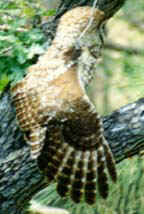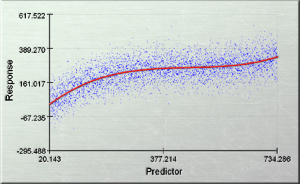
![]()


NAME: Grid and Theme Regression 3.1e (Click name to download)
Download PDF Version of Manual: Regression Manual (4.06 mb)
View and Download Grid and Theme Regression Poster
Aka: grid_regression.avx
Last modified: August 29, 2006
TOPICS: Regression, R-Square, Slope, Scatterplot, ANOVA, SLR, Grid, P-value, Statistics, Distributions, t, F, logistic, normal, skewness, kurtosis, binomial, probability, critical, Poisson, chi-square, Model, Sequential Sums of Squares, Parameter
AUTHOR: Jeff Jenness
Wildlife Biologist, GIS Analyst
Jenness Enterprises
3020 N. Schevene Blvd.
Flagstaff, AZ 86004 USA
[email protected]
DESCRIPTION: This extension allows you to conduct Simple and Multiple Linear Regression analyses for both tabular and grid data. Regression can be conducted with fields in a table or between grid datasets. This extension also gives you the ability to calculate a wider range of summary statistical data than that available in the standard ArcView interface, and the power to generate probability values and critical values from a wide range of statistical distributions.
![]() Linear Regression on Themes and Tables:
This function uses Least Squares methods to calculate the linear
relationship between one or more independent Predictor variables and a
dependent Response variable. Predictor and response values are drawn from
fields in an ArcView table or a point/line/polygon theme feature attribute
table.
Linear Regression on Themes and Tables:
This function uses Least Squares methods to calculate the linear
relationship between one or more independent Predictor variables and a
dependent Response variable. Predictor and response values are drawn from
fields in an ArcView table or a point/line/polygon theme feature attribute
table.
![]() Linear Regression on Grids:
This function calculates the linear relationship between
one or more grids of predictor values and a grid of response values, again
using Least Squares methods.
Linear Regression on Grids:
This function calculates the linear relationship between
one or more grids of predictor values and a grid of response values, again
using Least Squares methods.
![]() Summary Statistics: From any numeric field in a table, this function will
calculate the Mean, Standard Error of the Mean, Confidence Intervals,
Minimum, 1st Quartile, Median, 3rd Quartile, Maximum, Variance, Standard
Deviation, Average Absolute Deviation, Skewness (normal and Fisher’s G1),
Kurtosis (normal and Fisher’s G2), Number of Records, Number of Null Values,
and Total Sum.
Summary Statistics: From any numeric field in a table, this function will
calculate the Mean, Standard Error of the Mean, Confidence Intervals,
Minimum, 1st Quartile, Median, 3rd Quartile, Maximum, Variance, Standard
Deviation, Average Absolute Deviation, Skewness (normal and Fisher’s G1),
Kurtosis (normal and Fisher’s G2), Number of Records, Number of Null Values,
and Total Sum.
![]() Probability Calculators: This function will allow you to calculate the
probability, cumulative probability and inverse probability (i.e. given a
cumulative probability, calculate the corresponding critical value) of a
wide range of statistical distributions, including the Beta, Binomial,
Cauchy, Chi-Square, Exponential, F, Logistic, LogNormal, Normal, Poisson,
Student’s T and Weibull distributions. This function is available as a
general calculator that remains open until you are finished with it, or as a
Table tool that performs the calculations on all selected records in a
table.
Probability Calculators: This function will allow you to calculate the
probability, cumulative probability and inverse probability (i.e. given a
cumulative probability, calculate the corresponding critical value) of a
wide range of statistical distributions, including the Beta, Binomial,
Cauchy, Chi-Square, Exponential, F, Logistic, LogNormal, Normal, Poisson,
Student’s T and Weibull distributions. This function is available as a
general calculator that remains open until you are finished with it, or as a
Table tool that performs the calculations on all selected records in a
table.
Acknowledgments: This extension was developed for the Inland Water Resources and Aquaculture Service (FIRI) of the United Nations Food and Agriculture Organization (FAO), for use in a training program to teach managers how to utilize GIS technology when managing fisheries. See Geographic Information Systems in fisheries management and planning. Technical manual, by G. de Graaf, F.J.B. Marttin, J. Aguilar-Manjarrez & J. Jenness. FAO Fisheries Technical Paper No. 449. Rome. 162p. The author gratefully acknowledges the assistance of Felix Martin and José Aguilar-Manjarrez of FAO, and Gertjan de Graaf of Nefisco Foundation, for their assistance in developing the Grid Regression tools.
Certain tools (esp. the Field Statistics and the histogram) were originally developed by the author for the University of Arizona’s Saguaro project (see http://saguaro.geo.arizona.edu/) and are included here with their permission. The author thanks Larry Kendall of the University of Arizona, and Scott Walker of Northern Arizona University, for their help in developing those tools and their willingness to share them. The Theme and Table Regression tools were originally developed for the FAO-FIRI African Water Resource Database project, and portions of this manual are adapted from the documentation for that project. The author gratefully acknowledges the assistance of Joe Dooley of Spatial Data Services & Mapping (Namibia), and José Aguilar-Manjarrez and Claudia Riva of FAO for their assistance in writing and editing that manual.
The Statistical Probability tools are almost identical to those in the author’s Statistics and Probability Tools extension (see http://www.jennessent.com/arcview/stats_dist.htm) and are included because they enhance and complement the regression functions. The manual for that extension has also been adapted into this manual.
REQUIRES: Spatial Analyst
This extension also requires that the file "avdlog.dll" be present in the ArcView/BIN32 directory (or $AVBIN/avdlog.dll) and that the Dialog Designer extension be located in your ArcView/ext32 directory, which they usually are if you're running AV 3.1 or better. The Dialog Designer doesn't have to be loaded; it just has to be available. If you are running AV 3.0a, you can download the appropriate files for free from ESRI at:
http://support.esri.com/index.cfm?fa=downloads.patchesServicePacks.viewPatch&PID=25&MetaID=483
REVISIONS:
| Version 2.0 (January 22, 2004) adds tools for Theme and Table regression, plus incorporates the probability tools. | |||||||||||||
| Version 2.1 (May 16, 2004) repairs a bug that, in some circumstances, incorrectly calculated P-values and R-Squared values when there were null values in the dataset. | |||||||||||||
| Version 3.0 (August 13, 2005) adds functions to build custom models and conduct multiple regression analyses. | |||||||||||||
Version 3.1 (September 8, 2005)
| |||||||||||||
Version 3.1a (September 22, 2005)
| |||||||||||||
Version 3.1b (October 12, 2005)
| |||||||||||||
Version 3.1c (February 18, 2006)
| |||||||||||||
Version 3.1e (August 29, 2006)
|
Recommended Citation Format: For those who wish to cite this extension, the author recommends something similar to:
Jenness, Jeff. 2006. Grid and Theme Regression 3.1e (grid_regression.avx) extension for ArcView 3.x. Jenness Enterprises. Available at: http://www.jennessent.com/arcview/regression.htm.
Please let me know if you cite this extension in a publication ([email protected]). I will update the citation list to include any publications that I am told about.
![]()
General Instructions:
|
||||||||||||||||||||||||||||||||
|
||||||||||||||||||||||||||||||||
|
||||||||||||||||||||||||||||||||
|
||||||||||||||||||||||||||||||||
|
||||||||||||||||||||||||||||||||
|
||||||||||||||||||||||||||||||||
|
||||||||||||||||||||||||||||||||
|
||||||||||||||||||||||||||||||||
|
||||||||||||||||||||||||||||||||
|
||||||||||||||||||||||||||||||||
|
||||||||||||||||||||||||||||||||
|
||||||||||||||||||||||||||||||||
|
||||||||||||||||||||||||||||||||
|
||||||||||||||||||||||||||||||||
![]()
Enjoy! Please contact the author if you have problems or find bugs.
Jeff Jenness [email protected]
Jenness Enterprises http://www.jennessent.com
3020 N. Schevene Blvd.
Flagstaff, AZ 86004
USA
![]()
Please visit Jenness Enterprises ArcView Extensions site for more ArcView Extensions and other software by the author. We also offer customized ArcView-based GIS consultation services to help you meet your specific data analysis and application development needs.